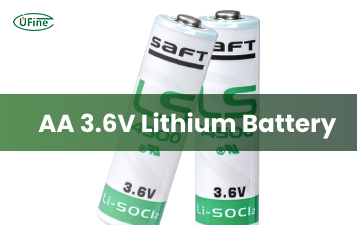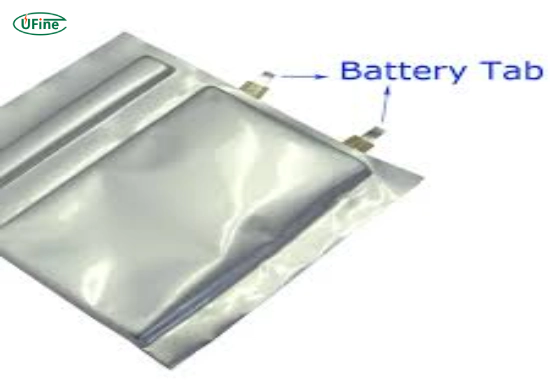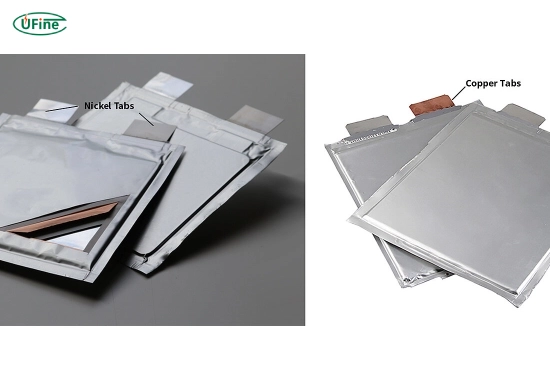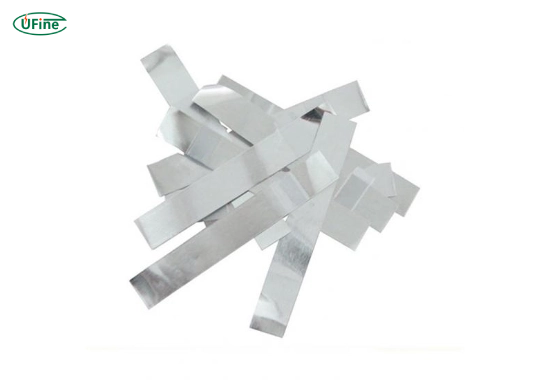A crucial component that plays a significant role in the performance of lithium batteries is the battery tab. Battery tabs are thin strips of conductive material that connect the battery’s active components, such as the anode and cathode. These tabs are essential for ensuring efficient energy transfer and overall battery functionality. This article will delve into the various aspects of battery tabs, including their types, manufacturing processes, and applications.
Part 1. What is the battery tab?
A battery tab is a metal strip or wire that connects the anode and cathode of a battery. It enables electrical current flow, playing a vital role in battery performance. It is a crucial connection between the battery cells and external devices, such as circuit boards or power terminals.
Manufacturers typically use conductive materials like copper or nickel to make battery tabs because of their efficient ability to conduct electricity while resisting corrosion. They are often welded or soldered onto the electrodes of battery cells during manufacturing.
These tabs are vital in ensuring reliable electrical contact within the battery pack. They enable the transfer of electrical energy from the battery to the connected device, allowing it to function correctly. Additionally, battery tabs help distribute current evenly across the cells, optimizing performance and prolonging battery life.
Part 2. Why are battery tabs important for lithium batteries?
a. Enhanced Conductivity
Battery tabs provide a low-resistance pathway for electrical current by design. High-conductivity materials like copper or aluminum minimize electrical losses and enable efficient charge and discharge cycles. This enhanced conductivity ensures the battery can deliver power effectively, maximizing its overall performance.
b. Mechanical Stability
Lithium batteries undergo physical stress during charging and discharging cycles. Battery tabs help maintain the battery’s structural integrity by securely connecting the active components. They act as anchor points, preventing the internal components from becoming loose or disconnected due to mechanical vibrations or movements. This mechanical stability is crucial for the longevity and reliability of the battery.
c. Heat Dissipation
During the operation of lithium batteries, they generate heat as a byproduct. Battery tabs, with their direct contact with the active components, aid in efficient heat dissipation. They act as conductors, spreading the heat evenly across the battery, which helps prevent localized hotspots. Effective heat dissipation can improve the battery’s lifespan and reduce the risk of thermal runaway or failure.
Part 3. Types of battery tabs: Nickel, Aluminum, and Copper
Nickel Tabs
Manufacturers commonly use nickel tabs in lithium-ion and lithium-polymer batteries because of their exceptional conductivity and resistance to corrosion. These tabs come in various forms, including spot-welded tabs and adhesive-backed tabs. Spot-welded nickel tabs are directly welded onto battery electrodes during manufacturing, providing a secure connection. Adhesive-backed nickel tabs offer flexibility in assembly, allowing for easy attachment to battery cells without welding. In high-performance applications where reliable electrical conductivity is essential, manufacturers prefer nickel tabs.
Aluminum Tabs
Aluminum tabs are lighter than nickel tabs, making them ideal for applications where weight is a concern. They offer good conductivity, and manufacturers often choose them for their lightweight properties, particularly in portable electronic devices and aerospace applications. However, aluminum tabs may have lower conductivity than nickel tabs and can be more challenging to weld. Despite these limitations, aluminum tabs remain popular for their lightweight and cost-effective characteristics.
Copper Tabs
Copper tabs boast excellent conductivity, making them suitable for high-current applications where efficient energy transfer is critical. However, copper tabs are prone to corrosion and oxidation, requiring protective coatings or treatments to maintain their performance over time. Manufacturers commonly use these tabs in custom battery designs and specialized applications where high conductivity is paramount. Despite their susceptibility to corrosion, copper tabs offer superior electrical performance, making them a preferred choice in specific battery configurations and demanding environments.
Part 4. Battery tabs manufacturing process
The lithium battery manufacturing process involves several critical stages to ensure the production of high-quality battery components, with battery tabs being one of the most essential. These tabs play a crucial role in connecting the anode and cathode of lithium batteries, ensuring efficient energy transfer and optimal performance.
1. Material Selection and Preparation
The first step in manufacturing battery tabs is the selection of high-quality conductive materials such as copper or aluminum. Manufacturers choose these materials for their excellent electrical conductivity and mechanical properties. Once selected, the raw materials undergo thorough preparation, including melting, refining, and casting into nuggets or strips.
2. Rolling or Extrusion
After the material preparation, the next stage involves shaping the conductive material into thin strips with the desired thickness and dimensions. Manufacturers typically achieve this through either rolling or extrusion processes.
- Rolling: In the rolling process, rollers gradually reduce the thickness of the conductive material as it passes through them. This continuous rolling action produces uniform and precisely controlled thickness strips.
- Extrusion: Alternatively, manufacturers can process the conductive material through extrusion. This involves forcing the material through a specially designed die to obtain the desired shape and dimensions. Extrusion allows for more complex tab designs while maintaining consistency in thickness.
3. Surface Treatment
Surface treatment processes are applied to enhance the performance and reliability of battery tabs. These treatments may include:
- Cleaning: Manufacturers thoroughly clean the tabs to remove any impurities, oils, or contaminants that could affect their conductivity or adhesion properties.
- Coating: A thin protective layer may be applied to the surface of the tabs to improve their resistance to corrosion, oxidation, or other environmental factors. This coating helps maintain the long-term stability and functionality of the tabs.
- Plating: In some cases, the tabs may undergo electroplating processes to enhance their electrical conductivity or improve their compatibility with other battery components. This can involve depositing a layer of a more conductive material, such as silver or gold, onto the tabs’ surface.
4. Cutting and Shaping
Once manufacturers complete the surface treatment, they cut the tabs into specific lengths and shapes according to the requirements of the target lithium battery design. Precision cutting techniques, such as laser cutting or stamping, ensure accurate dimensions and clean edges.
5. Quality Control
Manufacturers implement rigorous quality control measures to ensure the battery tabs meet the required standards. These include:
- Dimensional Accuracy: Measurements and inspections ensure that the tabs meet the specified dimensions, thickness, and tolerances.
- Conductivity Testing: We conduct electrical conductivity tests to verify the tabs’ ability to transfer electrical current efficiently without significant resistance or power loss.
- Visual Inspection: The tabs undergo visual examination to identify any surface defects, imperfections, or irregularities that could impact their performance or reliability.
- Durability and Adhesion Testing: The tabs are subjected to tests to assess their mechanical strength, adhesion properties, and resistance to bending or deformation. This ensures the tabs can withstand the stresses and strains experienced during battery assembly and usage.
Part 5. Applications of battery tabs
a. Electric Vehicles (EVs)
The automotive industry has recently witnessed a significant shift towards electric vehicles. Battery tabs are crucial in EV batteries, providing the necessary electrical connections for efficient power delivery. The high conductivity and mechanical stability of battery tabs are essential for the performance and safety of electric vehicles.
b. Portable Electronics
Battery-powered portable electronics, such as smartphones, tablets, and laptops, utilize lithium batteries. Battery tabs play a vital role in these devices by ensuring optimal energy transfer and long-lasting performance. The lightweight and compact nature of aluminum-plated tabs makes them particularly suitable for portable electronics.
c. Energy Storage Systems
Renewable energy sources like solar and wind require efficient energy storage systems to balance power supply and demand. Battery tabs are used in large-scale energy storage systems to connect multiple lithium batteries and create battery packs. These packs can store excess energy during periods of low demand and release it when needed.
d. Medical Devices
Medical devices, such as pacemakers, implantable defibrillators, and medical implants, often rely on lithium batteries for power. Battery tabs ensure reliable electrical connections within these devices, enabling them to function effectively and provide life-saving treatments to patients.
Part 6. FAQs
-
What is the negative tab of a battery?
The negative tab of a battery is a metal strip or wire that serves as the connection point for the negative electrode of the battery cell. It facilitates the flow of electrons during discharge and recharge cycles. -
What is the process of cell welding?
Cell welding is the process of joining battery tabs to the electrodes of battery cells. Manufacturers typically achieve this through spot or laser welding, securely bonding the tabs to the electrodes to ensure reliable electrical connections. -
What are the materials in a lithium-ion battery terminal?
The materials commonly used in lithium-ion battery terminals include metals such as nickel, aluminum, and copper. Manufacturers choose these materials for their conductivity, corrosion resistance, and suitability for welding processes. -
What is the best metal for battery terminals?
The best metal for battery terminals depends on various factors, such as the specific application, desired electrical conductivity, and cost considerations. However, nickel is often preferred for its excellent conductivity and resistance to corrosion, making it a popular choice for battery terminals in many applications. -
What material is the battery connection?
Manufacturers make battery connections using conductive materials such as metal tabs or wires. These materials, such as nickel or copper, facilitate the transfer of electrical energy between battery cells and external devices, ensuring the proper functioning of the battery system. -
What is a battery tab and why is it important?
A battery tab is a conductive strip that connects the anode and cathode of a lithium-ion battery, enabling efficient energy transfer. It ensures proper functioning and enhances the battery’s performance. -
What are the main types of battery tabs?
Battery tabs are typically made from materials such as nickel, aluminum, and copper. Each material offers unique benefits like conductivity, weight, and corrosion resistance. -
How are battery tabs manufactured?
The manufacturing process for battery tabs involves selecting conductive materials, shaping them through rolling or extrusion, applying surface treatments, and precision cutting to ensure durability and conductivity. -
Why is nickel commonly used for battery tabs?
Nickel is favored for its excellent conductivity and resistance to corrosion, making it a reliable choice for battery tabs in lithium-ion and lithium-polymer batteries. -
What role do battery tabs play in electric vehicles (EVs)?
In electric vehicles, battery tabs are crucial for connecting cells within the battery pack. They enable efficient power delivery and ensure the stability and safety of the battery system.
Related Tags:
More Articles

What You Need to Know About AA 3.6V Lithium Battery
Learn all about AA 3.6V lithium batteries—voltage, size, capacity, uses, and the best replacements. Discover why they’re powerful, and highly reliable.
What Are Lithium Salts and Why They Matter in Battery Electrolytes
Lithium salts in electrolytes are key to battery performance, powering everything from phones to EVs and shaping the future of clean energy.
Lithium AAA Battery Guide: Power, Performance & Chargers
Explore lithium AAA batteries—voltage, capacity, weight, top brands, and more. Learn how to choose the best battery for your device and why it really matters.
How to Calculate Watts, Volts, and Amps (With Simple Formulas and Examples)
Learn how to calculate watts, volts, and amps for lithium batteries with simple formulas and examples, ideal for EVs, solar, and energy systems.
Comprehensive Analysis of U.S. Tariffs on Chinese Lithium Batteries
U.S. tariffs on Chinese lithium batteries in 2025 impact costs, supply chains, and EV, energy storage, and electronics industries globally.






